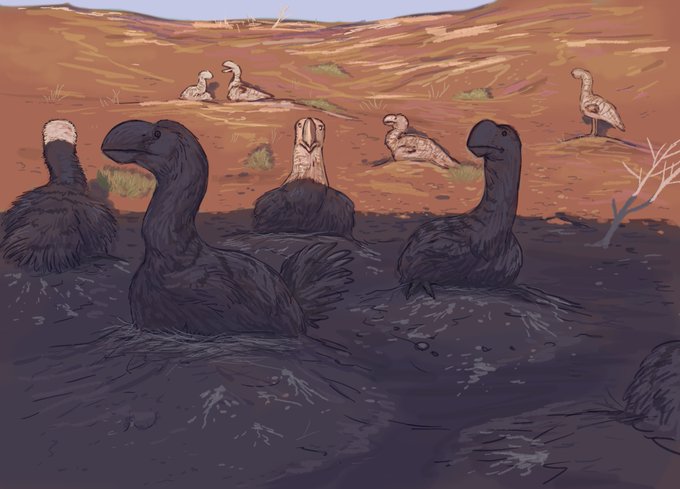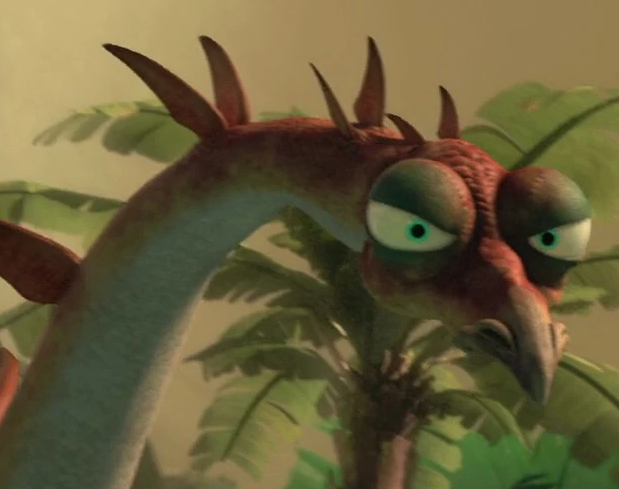eoceneのTwitterイラスト検索結果。 175 件中 6ページ目
#LiteratureNotice Nabozhenko et al. Taxonomic notes on the Eocene Helopini, and a review of the genus Isomira Mulsant, 1856 from Baltic amber (#Coleoptera: #Tenebrionidae) https://t.co/Lc5laIUdUt #Beetle #Beetles #DarklingBeetles #NewSpecies #Fossil #FossilFriday
Titanoides
A large mammal with long claws and tusks, originally it was the largest known animal form the paleocene, it belongs to one of the earliest large mammal groups
ALT: its known from multiple skull and tooth, ironically for how bear like they are, they where herbivores
Results from the #paleostream!
Gastornis, Antarcticarcinus and Lyrarapax.
#paleoart #birds #eocene #arthropod #ice #art #cambrian #sciart
This male Megacerops is about to take a chunk out of a rival's Brontotheriidae buttocks. Brontotheriidae are a family of now extinct odd-toed hooded animals that lived in Eocene North America. They were built like rhinos, but are more closely related to horses. #DrawDinovember
So, about horses that don’t look like horses: Propalaeotherium, one of the tiny Eocene equids. A wanderer of forest floors, more or less similar to today’s chevrotains and pacas.
Another to my favorite ancestor of whales, Ambulocetus natans (Walking Whale). Think of it as a crocodile-otter from the early Eocene about 50 MYA. It was thought to have lived in brackish estuaries of what is now Pakistan. Illustration by Rebecca Dart. 🤓🐉
Today's #DrawDinovember isn't a dinosaur at all, but an ancestor to whales, Ambulocetus (Walking Whale). Think of it as a crocodile-otter from the early Eocene about 50 MYA. It was thought to have lived in brackish estuaries of what is now Pakistan. #Paleoart
While some Thyreophora are either carnivores or omnivores now, some have still retained their herbivorous diet. This implies that the families of Stegosaurids and Ichthyostegids may have got separated very early on, perhaps way back in the Eocene.
The oldest bear dogs lived during the mid-Eocene and probably looked something like Gustafsonia, which carries the hallmarks of a small, forest-dwelling generalist. Gustafsonia was found in Texas, pointing to a North American origin for Amphicyonidae.
(Coluberssymbol)
Felt the urge to show appreciation to yet another group of Afrotherians, the Sirenians (dugongs and manatees) . This time I present to you the earliest member of Sirenia, meet Prorastomus from the Early Eocene of Jamaica. Sirenian evolution is quite interesting
#paleontology
Since Hyraxes are very awesome. I present to you yet another extinct Pliohyracid. Meet Antilohyrax, a hyrax from the Late Eocene of Fayum, Egypt. A hyrax that resembled a gazelle, had tusks and a low metabolism for an animal its size. It was a cursorial browser.
#paleontology
"Redescription and phylogenetic affinities of the caimanine Eocaiman cavernensis (Crocodylia, Alligatoroidea) from the #Eocene of #Argentina" by @PedroLGodoy et al in Papers in #Paleontology (@ThePalAss)
https://t.co/5GCqurWHeH
#crocodile #croctober #caimaninae
@MetTiinA Maybe some of the extinct animals of Spec? Like the Eocene spinosaurid (I guess that could be another type of dinosaur).
WOW. 2013 Paper: A Re-Interpretation of the Eocene Anuran Thaumastosaurus Based on MicroCT Examination of a ‘Mummified’ Specimen @PLOSONE #France
https://t.co/ig7XCvhk91
Seen thanks to @DarioEstraviz @carnoferox
Drawing underrated prehistoric animals 10/?: Stylinodon, a taeniodont from the middle Eocene period. We don’t know a lot of things about this mammal but it had strange canines turned into huge incisor-like teeth - maybe it ate roots?
Great new Palaeontologica Electronica publication by Aime Rankin, Bob Emory, and Rob Asher: https://t.co/i1L3Y2OdWt. Beautiful @NMNH specimens of Eocene fossil rodents archived on MorphoSource: https://t.co/UoFXdXjmHZ
IRSNB 254 is an Eocene crocodilian from Leval (Belgium), couple of years ago its name was Crocodylus depressifrons. #paleoart #crocodilians #cenozoic
"Basilosaurus Cetoides"
Basilosaurus was an extinct species of large predatory whale belonging in it's own group know ans archaecete. it lives in eocene epoch in the giant tethys sea where it now known as the dry sahara desert.
#paleoart #drawing #whale #basilosarus #digitalart
New paper from South American colleagues: Oops, fossil jawbone from Eocene of Antarctica originally identified as a bony toothed bird is actually... just a fish. https://t.co/yAY6dYrOuC













































